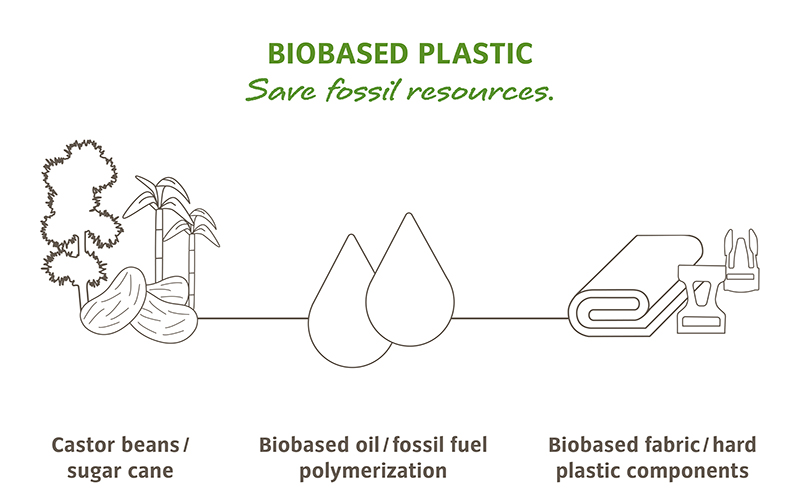
Synthetics from renewable resources
Forward to nature
VAUDE uses synthetic materials such as polyester, polyamide or polyurethane for many of its products. These materials are derived from petroleum.
We have set ourselves the goal of increasing the amount of renewable raw materials we use. In this way, we can use less fossil fuel-based resources and avoid adding more plastic to the planet.
Our concrete objective is:
By 2024, 90 % of all VAUDE products will have a recycled or biobased material content of more than 50 %.
Animal-based, plant-based, recycled, biobased
Renewable resources can be natural plant fibers such as organic cotton, hemp or kapok. Animal-based raw materials such as down, merino wool or leather can also be an alternative to synthetic materials. Fibers from cellulose are also suitable, such as fibers from wood, a renewable resource. Read more here
In addition to the use of renewable raw resources, we are focusing on using materials from existing closed loop cycles and breathing new life into them. This helps us to conserve valuable resources by using a variety of recycled materials in our products. Read more here
Plant-based materials for our products
Tank made from sugar – Eco-friendly water bottle made from biobased plastic
Bioethanol can be extracted from the sweet sucrose juice of the sugar cane plant, which is used to make our VAUDE Bike Bottle Organic.
The raw material for the bottle is supplied by the Brazilian company Braskem, a specialist in organic plastics. The bottle is then manufactured by a plastic processing company in Wangen in southern Germany.
The material for the bite valve, lid and the bottle itself is biopolyethylene which is naturally BPA-free and 100% recyclable.
Like any other green plant, sugar cane absorbs and binds large amounts of CO2 as it grows. This raw material is obtained from sustainable sugar cane cultivation in Brazil. It involves increased use of the fourth and fifth harvests of existing agricultural land, which otherwise yields too low a sugar content for the sugarcane industry to use. The BonSucro production standard is focused on fair working conditions, resource efficiency, biodiversity and is compliant with EU agricultural directives. Genetically modified crops are never used.
Coffee grounds for waterproofing
We have managed to substitute fossil components with biomass in our Ceplex Green membrane.
With this innovative technology, up to 25 % of conventional polyurethane is replaced by s.Café®. The biobased material is obtained from recycled coffee grounds and then processed in our highly functional Ceplex Green membrane.
Read more here
Zips and textiles made from castor oil
We have also been using bioplastics for hard plastics and textiles since 2018. Using polyamides with a renewable content of over 2/3, this biobased content comes from the oil of the castor plant.
The robust castor plant grows without additional irrigation on barren soils that are unsuitable for growing food. The oil is pressed from the plant’s beans and can be used to make textiles as well as plastic components such as zips and buckles.


»The castor bean plant doesn't require fertilization or artificial irrigation, grows in dry areas that aren't suitable for other types of agriculture in the first place - and is a popular food for caterpillars but inedible to humans and other mammals. The oil is made from the seeds, but unlike the seeds is completely non-toxic. «
Bioplastics for durable products
We can reduce the need for fossil resources by using materials from renewable resources.
Bioplastics can have a wide variety of properties: either equal to or even better than those of conventional plastics, for example lower weight or better impact strength.
We are continuously working on bringing new bioplastics to the market and using them in our industry. The EFFECTIVE project gives an indication of this. In this ambitious project we are developing the world's first biobased polyamide 6 together with international partners. You can find information about this project here
Criteria and trade-offs
Renewable resources are clearly a good option. Unfortunately, there are a few pitfalls that need to be avoided.
Competition with food cultivation
Biobased plastics are produced from plants such as corn, sugar cane and castor beans. This means that agricultural land is required for their cultivation and they are sometimes subject to criticism that their cultivation could compete with food production. The German Federal Environment Agency and the WWF point out that their cultivation could have environmental impacts such as acidification and eutrophication of soils or loss of forest areas. According to current industry figures, about 0.02 percent of the world's agricultural land is used for cultivation to produce bioplastics, so they take up only a very small share. Nevertheless, it is important to us that plant-based raw materials for bioplastics should not be in direct competition with food crops wherever possible. It is not easy to rule this out completely, as various complex aspects are relevant for the assessment.
For example, there are plants such as castor bean that grow without fertilization on dry, poor soils that are not suitable for food production and are therefore not in direct competition with food cultivation. Nevertheless, arable land is needed and it is also important to consider whether forest land, for example, has been cleared for the development of an agricultural area. If this is the case, the question follows whether appropriate compensatory measures for nature have been created.
In addition to looking at the area and methods of cultivation, it is also relevant for the assessment which components of the plant are used as raw materials for bioplastics. In other words, it is a question of whether the fruit itself (which could also be used as food) is used, or whether “residuals” and co-products, (only roots, stems or other waste parts of the plants, for example) which cannot be used for food production - can be used.
So before we choose a biobased material, we enter into a close exchange with our suppliers with the aim of drawing up an environmental assessment that’s as holistic as possible and alined with our Material Policy, taking into account all relevant aspects.
Genetic engineering
Due to the high level of public attention on genetic engineering and the current relevance for us with regard to the production of biobased plastics, we at VAUDE have taken a close and nuanced look at this issue.
According to a directive of the European Parliament, genetically modified organisms (GMOs) are organisms whose genetic material has been altered in a way that is not possible naturally through crossbreeding and/or natural recombination. The possible applications of genetic engineering are extremely diverse and almost inexhaustible, and can be evaluated both positively and negatively. With regard to the cultivation of crops as feedstock for bioplastics, the focus is on both the use of genetically modified plants and genetically modified microorganisms.
Genetically modified microorganisms are already widely used in the field of medicine, for example in the production of insulin for diabetics or for the production of mRNA vaccines. Another area of application is in the industrial production of bioplastics. In contained fermentation processes, genetically modified microorganisms enable the production of biobased plastics with greater efficiency and yield. This improves the life cycle assessment of biobased plastics production. That makes an important contribution to eliminating the use of limited fossil resources and using renewable resources as raw materials instead. If microorganisms have been generated exclusively for use in contained systems and are not viable outside of these systems, the use of these microorganisms does not pose any risk to humans or the environment. From this perspective, we see the use of these microorganisms as reasonable and justified.
Genetically modified crops such as cotton, soy or corn, which are already grown in many regions of the world, have unpredictable effects on their surrounding environment, ecosystems and biodiversity. Although many of the potential risks have been poorly substantiated in previous studies, the use of certain pesticides, for example, has been greatly increased by the use of pesticide-resistant crops. Due to the unpredictable and sometimes difficult-to-control effects of these organisms on their environment, we reject the use of genetically modified plants at VAUDE.
Our Material Policy therefore clearly states that we do not want to use any genetically modified plants in our products. We would prefer to have this confirmed by our suppliers for our biobased materials with an independent test certificate. Unfortunately, we have not been able to implement this so far because the quantities we buy are not large enough. Our suppliers buy large quantities of raw materials on the world market and use them to produce bioplastics; unfortunately, proof of testing and thus traceability on a batch basis are not possible. Since this issue is so important to us, we carry out case-by-case checks and discuss the critical points with our respective suppliers. Our minimum requirement is a self-declaration regarding freedom from genetic engineering. This is available to us for all biobased materials used in our products. More information about our Material Policy can be found here
Biobased or biodegradable
Synthetics that are made from renewable resources rather than petroleum are highly innovative. Frequently, these types of bioplastics are equated with “biodegradable” or “compostable” – but this isn’t always the case. Many biobased synthetics have exactly the same properties as conventional plastics. This usually includes their low biodegradability. By the same token, there are also conventional, petroleum-derived plastics that are biodegradable. This means that the origin of the material, whether it’s biobased or petroleum-based, is independent of how biodegradable it is.
You can find out more about the biodegradability of plastics and other materials here

| GRI: | 301-1 |




